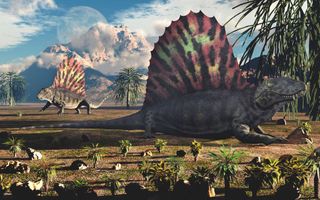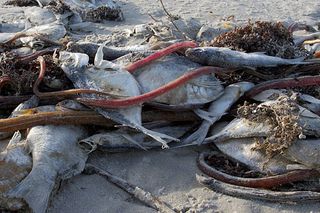Toxic gas released by ancient microbes may have worsened Earth's largest mass extinction
Hydrogen sulfide is both stinky and incredibly dangerous.

Algal blooms in coastal waters and toxic chemical exposures at oil facilities are modern problems. Their root causes, however, have a lot in common with the largest mass extinction in Earth's history 250 million years ago.
298.9 million years ago the Permian period, the last period of the Paleozoic era, began. This period of time had plenty of aquatic animals and archaic land creatures like dimetrodons. Scientists think that towards the end of the Permian period, volcanoes in Siberia went into overdrive and dramatically warmed the planet, triggering the Permian extinction, the most devastating decimation of life on Earth when about 95% of all marine species, as well as about 70% of terrestrial species, disappeared.
But scientists are still puzzled about how exactly the volcanic eruptions caused this mass extinction, often referred to as "the Great Dying." Researchers at the University of California Riverside tried to get to the bottom of this mystery in a new study, published in the November 2021 issue of the journal Nature Geoscience.
Related: Wipeout: History's most mysterious extinctions

The problem with hydrogen sulfide
According to this study, during this period of time, the warming planet raised ocean temperatures which led to certain aquatic microbes revving up their metabolisms, causing the microscopic critters to release a toxic gas called hydrogen sulfide that subsequently killed off so many of Earth's animals.
Oxygen levels in the oceans heavily decreased at the end of the Permian period. This pushed microbes to start ingesting sulfate, a substance that can be found in today's drinking water but which at high doses can lead to adverse medical symptoms like diarrhea )or worse), according to the U.S. Environmental Protection Agency.
By ingesting this sulfate, t ancient microbes then "produced hydrogen sulfide, a gas that smells like rotten eggs and is poisonous to animals," Dominik Hülse, UC Riverside Earth system modeler, said in a statement about this study.
Get the Space.com Newsletter
Breaking space news, the latest updates on rocket launches, skywatching events and more!
Hydrogen sulfide is both stinky and incredibly dangerous. In 2019, two people died at an oil facility in Odessa, Texas, due to poor protocol that exposed them to toxic gas. The hydrogen sulfide was pumped up from the ground along with oil; both came from a Permian layer of rock.
During the Permian extinction, the world's oceans began experiencing what is known as euxinia, a phenomenon caused by a combination of high hydrogen sulfide levels and low oxygen levels.
"Our research shows the entire ocean wasn’t euxinic. These conditions began in the deeper parts of the water column," Hülse said. "As temperatures increased, the euxinic zones got larger, more toxic, and moved up the water column into the shelf environment where most marine animals lived, poisoning them."

The past and the present day
This research may help scientists to find answers to an ancient mystery, but it is also a timely reminder about the ocean's sensitivity to climate change.
Currently, climate change is causing sea levels to rise, one of many consequences that progressively threaten life on Earth. But climate change can also disrupt the oceans in another dangerous way.
Earth's carbon cycle is heavily tied up with its oceans, beginning with little creatures called phytoplankton. These microscopic beings breathe in carbon dioxide, release oxygen and munch on organic material. They are the foundation of the aquatic food chain and are responsible for most of the transfer of carbon dioxide from Earth's atmosphere to the ocean.
When they die, these photosynthesizers fall to the depths of the ocean as "marine snow," becoming food for microbes. It is there that the microbes transform that material into inorganic matter in a process called remineralization. The depths at which this occurs in the oceans play a huge role in how life is supported throughout the planet, especially marine life.
The microbial disaster that may have triggered the largest extinction in Earth's history also echoes in modern algal bloom events. This is a major issue for coastal waters around the world as run-off from modern human activity enriches the water near land and causes certain microbes to flourish. If they promote euxinia, animals die from lack of oxygen or toxic hydrogen sulfide. Close exposure by land is dangerous, too.
According to the statement describing the new study, euxinic waters can be found in places like Los Angeles County’s 16-mile-long Dominguez Channel. Just a few months ago, a warehouse fire released ethanol, which then killed vegetation in the channel. When microbes consumed this decay, they produced hydrogen sulfide at toxic levels and caused thousands of people to experience symptoms such as vomiting, diarrhea, dizziness, insomnia and headaches.
Follow Doris Elin Urrutia on Twitter @salazar_elin. Follow us on Twitter @Spacedotcom and on Facebook.
Join our Space Forums to keep talking space on the latest missions, night sky and more! And if you have a news tip, correction or comment, let us know at: community@space.com.

Doris is a science journalist and Space.com contributor. She received a B.A. in Sociology and Communications at Fordham University in New York City. Her first work was published in collaboration with London Mining Network, where her love of science writing was born. Her passion for astronomy started as a kid when she helped her sister build a model solar system in the Bronx. She got her first shot at astronomy writing as a Space.com editorial intern and continues to write about all things cosmic for the website. Doris has also written about microscopic plant life for Scientific American’s website and about whale calls for their print magazine. She has also written about ancient humans for Inverse, with stories ranging from how to recreate Pompeii’s cuisine to how to map the Polynesian expansion through genomics. She currently shares her home with two rabbits. Follow her on twitter at @salazar_elin.
